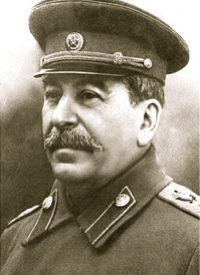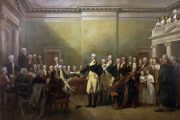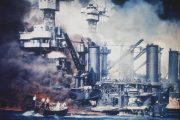
Seventy-five years ago, on January 25, 1937, the terror known generally as the Moscow Show Trials entered its second phase. The first phase began in August, 1936, and the intended political enemies of Stalin constituted the “Trotskyite-Zionvievite Terrorist Center.” This was a purging of the notional “left” within the Communist Party of the Soviet Union. Grigory Zinoviev and Lev Kamenev were among the most prominent members in this purge. Zinoviev had been considered one of the leading theoreticians of the party. Kamenev had been the head of the Moscow Soviet and then the Deputy Premier under Lenin. Zinoviev and Kamenev followed Stalin (left) in pushing Trotsky out of party leadership in 1924.
The second phase, the one which began 75 years ago, included 17 Soviet and Party officials, all but four of whom would end up being executed (the other four were sentenced to the Gulag, where the mortality rate was generally very high). As was true with all the Show Trials, the public trial began only after the horrors of the Chekists had coerced confessions; however, there was more to the trials that just torture and physical hopelessness. The Bolsheviks believed in nothing except for the Party. If they were accused by the Party of crimes, then they must have done something wrong. The confessions wrung out of the defendants in the January 1937 Show Trials provided Stalin with the pretext for his 1938 Show Trials, which were against the “Rightist-Bloc.”
The final Moscow Show Trial period was in March 1938, and the defendants, who included Rykov (who had been premier), Bukarin (past head of the Communist International), and Yagoda, and 18 others — were tried and convicted. The pattern in these trials was the same: the most slavish earlier followers of communism confessed to the most incredible charges and typically requested the death penalty as due punishment for their “crimes.”
The Show Trials were one aspect of the Great Terror under Stalin, in which “wreckers” — engineers or managers of projects which did not work the way Stalin and the Politburo thought — were forced into confessions and sent to the Gulag by the hundreds of thousands.
What happened after their arrest is not known precisely, though presumably it was brutal. That they and the other members of this “center” were interrogated and tortured is almost certain; that members of the family were brought before them and threatened with torture seems likely. Even the name of the organization which engaged in this cruel behavior morphed over time. At the time of the Bolshevik Revolution, the political police was called the “Cheka,” but by 1922 the “Cheka” had become the GPU or “State Political Directorate” within the NKVD or “People’s Commissariat for Internal Affairs.” This name was changed, according to Tiltman in his 1931 book, The Terror in Europe “because of the odium and fear attaching even among Communists to work for the Cheka, it was decided that the organization should thereafter be called the State Political Administration (G.P.U.)”
In 1923, the GPU became the OGPU or “All-Union People’s Commissars of the USSR.” Then, shortly before the first Show Trials began, the OGPU became the GUGB or the NKVD or “Main Directorate for State Security,” and the NKVD for the Russian Soviet Socialist Republic (the largest of the many nations within the Soviet Union) ceased to exist. In 1941, long after the Show Trials ended, the GUGB was taken out of the NKVD and a new creature, notionally, the NKGB “People’s Commissariat for State Security” was born. In 1954, the KGB or “Committee for State Security” was formed. Why all these changes, which did not mean any changes at all?
No one was allowed, not even the secret police in the Soviet Union, to ever feel on solid ground or safe at all. Yagoda, who had been the head of the NKVD when Kamenev and Zinoviev were tried and condemned in August 1936 had himself been deposed by Stalin and replaced with Yezhov. Yagoda would, himself, be tried, convicted and executed after the third round of the Show Trials in of 1938. Within months of Yezhov extracting a confession from Yagoda, Beria took over the job of Stalin’s political police chief and Yezhov was arrested, found guilty and was soon dead. Beria remained until after Stalin died, after which he, too, would be arrested and executed.
Despite that, many western observers like Joseph Davies, FDR’s ambassador to the Soviet Union, determined that the trials were fair. Davies, for example, wrote in Mission to Moscow, that “It is generally accepted by members of the Diplomatic Corps that the accused must have been guilty of an offense which in the Soviet Union would merit the death penalty.” Stalinist Lillian Hellman, reacting to the January 1937 Moscow Show Trials, denounced any criticism to the show trials in her “Open letter to American liberals.” Beatrice Webb, a long-time British apologist for Stalinism, pronounced that she was happy that Stalin “cut out the dead wood.”
It was against this backdrop that one of the earliest dystopian classics, Darkness at Noon, by Arthur Koestler was published. In a gloomy prison with other defendants (all of whom, of course, were ultimately found guilty of the gravest crimes), Rubashov, the fictional protagonist in that novel, has not only sacrificed everything of value in his life for the Party, but he has also betrayed other Bolsheviks to the Party as well. As he knows when he is first arrested, execution is the only way he will ever leave prison.
Ultimately in the three phases of the Moscow Show Trials and connected purges usually known as the Great Terror or the Great Purge, every member of the Politburo under Lenin except Stalin was condemned. There were 1,966 delegates to the 1934 Party Congress, and out of those 1,108 were arrested and convicted. The Central Committee had 139 members and 98 were arrested and convicted. The Red Army leadership was decimated so that the odds of a front or a corps or an army actually having at experienced commander at the time of Operation Barbarossa in June 1941 was about ten percent.
Perhaps the most amazing reality after the Moscow Show Trials was that anyone still believed in the word of the Soviet Union or the Communist Party. Yet communists remained communists. When Stalin railed against “Hitlerites” and “German Fascists” (two nonsensical terms invented by Stalinists and accepted by Nazis because it concealed their true nature), communists around the world joined their voices to his. When Stalin became a practical ally of Hitler, then all these voices shifted, as one, into condemnation of Britain and France. When Hitler turned east, the same voices yammered for a “second front” against Hitler by the democracies, and when Stalin marched halfway across Europe, these voices called for “peaceful coexistence.”
Seldom, if ever, in human history has the delusional nature of a whole group of elites been so exposed as in the Moscow Show Trials, yet today it is uncertain what, exactly, we have learned from this object lesson of history.



